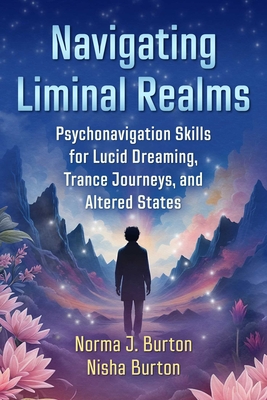- Home
- Editor's Notes
- Current Issue
- Riki Reflects
- Spiritual Traveler
- Starz Emporium
- Classifieds
- Advertise with Us
- Submissions
- Awards
- About Us
- Contact Us
Navigating Liminal Realms
By Norma J. Burton and Nisha Burton
 Chapter One
What Is Psychonavigation? Psychonavigation is not a term we typically hear in our daily conversations; however, its meaning can be easily understood when divided into the two words that comprise it: PSYCHO (aka the psyche) – The human soul, mind, or spirit. Within psychology, the psyche is the totality of the mind, both the conscious and unconscious parts. NAVIGATION – The process or activity of accurately ascertaining one’s position and planning and following a route. Thus, bringing these two concepts together, the act of psychonavigation is the ability to accurately understand your position within your psyche. By gaining access to the maps of your own mind you can plan a route within your inner terrain with skill. Navigating consciousness with expertise is a quest that humans have been on for centuries. From philosophers to shamans, the desire to understand what the mind is and how to traverse its various states has been at the core of what it means to be human. Thus, the investigations into consciousness, so popular now in the burgeoning field of psychedelic studies, are nothing new to humanity. Despite all the centuries of inquiry, the intimate cosmos of human awareness still remains elusive to modern science. Now researchers are flocking like bears to honey to do lab studies on the human brain under the influence of mind-altering substances. The brain has been called, “the most complex object in the known universe,” by leading researcher Christof Koch. Perception is not only altered by psychoactive substances. Many factors, such as social influences, beliefs, fasting, breathwork, meditation, and prolonged exertion, can alter your perception. When your perception shifts you can see the world in an entirely new way; sometimes it is subtle, and other times it is almost as if you are in a completely different reality. Altering your perception, you can notice things that you missed in your habitual ways of perceiving reality, thus leading to breakthroughs. Carlos Castaneda’s written works are well known. However, most people have read only his books about working with his Yaqui teacher Don Juan while using strong hallucinogenic substances. Throughout this book, we will reference Castaneda’s book The Art of Dreaming, which was one of his later titles. In that book, psychedelic substances are not the focus; instead, reality is shifted through lucid dreaming practices. Don Juan explains to Castaneda that psychedelics are not necessary to shift perception. However, when Castaneda first came to Don Juan, he was very stuck in his habitual view of reality, so Don Juan used psychedelics to shake Castaneda out of his stuck viewpoint. Not knowing this, some believe that Castaneda’s work with Don Juan was all about psychedelics, but they were just the beginning of his journey into altered states of consciousness. Hallucinogens can be helpful, radically taking us out of our habitual perspective on reality, but they are not the only way to break out of mundane reality. When altering the brain with external substances one should take precautions, because our brains are infinitely complex. The complexity of the mind is still a great mystery to scientists, yet profound studies at this interface of science and consciousness are now being published. There was a fascinating study conducted by astrophysicist Franco Vazza and neuroscientist Alberto Feletti.1 The two joined forces to compare the complexity of galaxies with human brain neuronal networks. They found that “The total number of neurons in the human brain falls in the same ballpark as the number of galaxies in the observable universe.” The memory capacity of the brain is so large (around 2.5 petabytes) that a computer with a similar processing capacity could reproduce the entire universe at its largest scales. The microcosm of our individual brain is reflected in the macrocosm of the universe. Our mental computers are literally creating the reality we perceive in every moment. To see things in this context is to realize that navigating our own minds can be just as complex as a space explorer traveling from galaxy to galaxy. Would you go out into the vastness of space without any understanding or preparedness of how to get from point A to point B? Probably not, and yet humans often haphazardly rush into altering their psyches with cavalier abandon. When altering the mind, we are dealing with something vastly complex—it requires a great deal of humility, awe, and skill. To become a true psychonavigator one must dedicate themselves to walking this pathway diligently. Chapter Two Oneironauts, Psychonauts, and Reasons to Enter the Liminal Lucid dreamers are often called oneironauts, which is a combination of the Greek words for dream (oneiro) and nautical voyager, or sailor. Oneironautics is the ability to travel within a dream with lucidity and conscious awareness. While astronauts travel into the vastly unknown landscapes of outer space, oneironauts travel into the vastly unknown landscape of inner space. Similarly, the word psychonaut comes from the Ancient Greek psyche (soul, spirit, mind) and naut (sailor, navigator). Although it’s come to be predominantly associated with psychedelic use it actually means navigation of the psyche through various means, such as meditation, lucid dreaming, brainwave entrainment, trance journeys, and mind-altering substances. Thus, this term can describe anyone venturing into the psyche regardless of the route that they take. Jan Dirk Blom, a clinical psychiatrist, describes a psychonaut as someone who “seeks to investigate their mind using intentionally induced altered states of consciousness for spiritual, scientific, or research purposes.”2 When you step onto the pathway of navigating your psyche with lucid awareness you can think of yourself as a voyager into the vast recesses of the Great Unknown within your own mind. The reasons you may enter into this exploration of your inner cosmos can be both spiritual and psychological. Philosophy is fascinated with understanding the psyche because it’s at the core of understanding the human condition. Cultures and peoples through time and history have grappled with what it means to work with the mind and spirit. Entering and altering the mind in order to better understand oneself and one’s place in reality has been a constant exploration, from Tibetan Buddhists, to shamans of South America, to the Siddhars of Ancient India, all the way to people engaging in psychedelic therapy in our current age. Stepping into the Liminal Voyager, on the journey of psychonavigation you step up to a portal, a doorway, between Ordinary Reality and the Dreamtime. To be in a liminal space is defined as “a state or place characterized by being transitional or intermediate in some way.” On the internet, there is a whole fascination with liminal spaces, and they are informally described as any location that is unsettling, uncanny, or dreamlike. However, interest in liminal spaces is nothing new. In Tibetan Buddhism, the Bardo realms are essentially liminal spaces. According to this worldview, when a person dies and leaves their body, the soul traverses the Bardo realms and is eventually reborn. These liminal realms in which the soul travels in between realities must be carefully navigated. There are many teachings surrounding what to do in these Bardo realms. The Tibetan Book of The Dead (Bardo Thodol) is an ancient, detailed map used to help guide newly deceased souls through the Bardos to enlightenment or a beneficial rebirth. It reminds the soul to look beyond the illusions of the mind that can be scary and confusing. Dream yoga is a spiritual practice rooted in Tibetan Buddhism that involves the use of dreams and lucid dreaming to work with the “Bardos of the Dreamtime” in order to prepare for the “Bardos of Death” after we have left this body behind. In Western terms, learning how to navigate the psyche while alive through lucid dreaming and drum journey trance states prepares you to successfully navigate consciousness at the time of death. Regardless of your particular view of what happens after death, knowing how to work with liminal states of consciousness is an invaluable tool throughout life. Learning to navigate the psyche is a journey of learning how to safely venture in and out of various states of consciousness while maintaining awareness, and thereby successfully making it through the liminal spaces in between.  Author Bio: Norma J. Burton is a counselor with a degree in comparative religion focusing on Buddhist and shamanic traditions, who specializes in trauma healing, shadow work, and dream analysis. Having apprenticed with Indigenous elders for over 30 years, she founded the Institute of Ancient Healing Arts and the Circle of Trust Healing Center. https://normaburton.com https://luciddreaminglucidliving.com  Nisha Burton is a dreamworker, award-winning filmmaker, and branding consultant for Fortune 100 companies. She is a speaker and teacher at universities. Norma and Nisha live in Ashland, Oregon. https://nishaburton.com Navigating Liminal Realms by Norma J. Burton and Nisha Burton published by Inner Traditions International and Bear & Company, © 2025. All rights reserved. http://www.Innertraditions.com Reprinted with permission of publisher. |
Share this article with friends!
|
Copyright © 1998 - 2025 Mystic Living Today All rights, including copyright, in the content of these Mystic Living Today web pages are owned or controlled for these purposes by Planet Starz, Inc. Terms of Service Disclaimer and Legal Information For questions or comment, contact Starzcast@mysticlivingtoday.com. Reproduction of this page in any form is not allowed without permission of the author and the owner of this site. All material on this web site, including text, photographs, graphics, code and/or software, are protected by international copyright and trademark laws. Unauthorized use is not permitted. You may not modify, copy, reproduce, republish, upload, post, transmit or distribute, in any manner, the material on this web site. Unless permissions is granted. |



